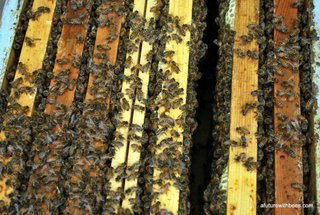![]()
A fresh article about splitting winter bees and the mistakes of doing it too early
One of the best ways to increase your apiary/number of hives is to make splits in the spring when the bees are naturally making increase and preparing to swarm. In other words, take advantage of their natural inclination to swarm and channel that energy into producing splits. Turning lemons into lemonade!
A split is a man made swarm. A swarm is a natural split done by the bees
If done well, it will allow the hives to fulfill their natural inclination to reproduce (because that's what a swarm is), and leave the hive in a position to still produce a full honey crop. You can get a full honey crop, and, grow the apiary!
Important concept: When we are talking about making a “split”, it does not mean we split the hive into two equal parts. It means that we take only the surplus frames from a hive.
The goal is to simulate a natural swarming event (swarming = split) and leave the parent hive in a position to recover fast enough to still produce a crop of honey. If we split the hive evenly, the parent hive would not be able to recover fast enough. It usually takes more than one hive to produce a good split.
In my area of Southwestern Missouri, I find that I can leave the parent hive with 4 frames of brood in April and they will still grow to full strength in time to make a full honey crop. This means that anything over 4 frames of brood is “excess” . Those excess frames can be pulled to make splits/nucs/cell builders/whatever (I will use the term splits for this article). When I go through a yard, I pull all excess frames from each hive and combine them temporarily in a brood carrier box. When I'm done going through all the colonies in the yard, I know how many excess frames I have. The excess frames can then be divvied up into splits and given queen cells (which were started last week).
Important concept: Don't try to predetermine how many frames you are going to pull from each hive. I often hear comments like “I plan to pull 3 frames from each hive”. Instead, plan to pull only the excess frames, not a predetermined amount. Let the bees dictate how many frames are available. Then the operation will stay more balanced and able to respond well. One of my goals is to keep my operation and my bees healthy and “in-balance”.)
These splits are made as early as possible so they can grow and increase during the spring nectar flow. This is the time of year the bees would naturally try to swarm. Why? Because it is the best time to start a new colony – when there are abundant resources at hand.
In good years, these splits will raise a queen and grow into full production hives by mid summer. In poor years, some of these splits will not succeed. In years when we get prolonged cold snaps or rainy periods, the success is not as good. Short cold snaps or nights below freezing don't seem to have much effect, but periods of cold longer than 3-4 days has a strong effect. So, it is often a gamble deciding how early to start splits – we're betting on the weather, and nothing is more unpredictable than the weather!
Important concepts:
-
-
It takes more than one hive to make a split
-
A hive is not split evenly, we just pull the “excess” frames
-
The goal is to simulate a natural swarming event
-
A split is a man made swarm. A swarm is a natural split done by the bees
-
I hope that sharing my mistakes and experiences will help you understand why these choices are necessary and will help the bees. #afuturewithbees #savethebees
